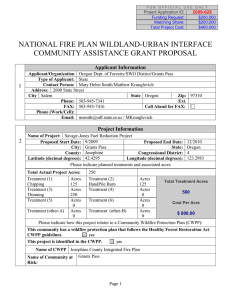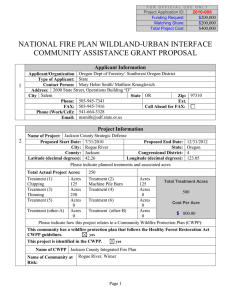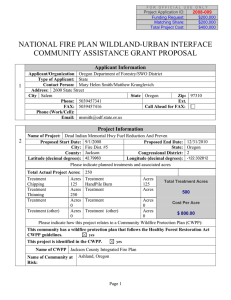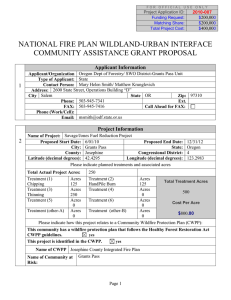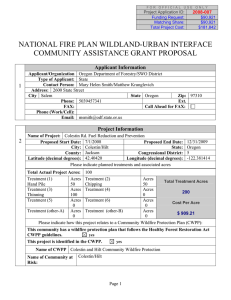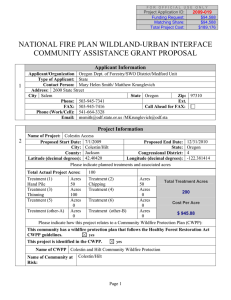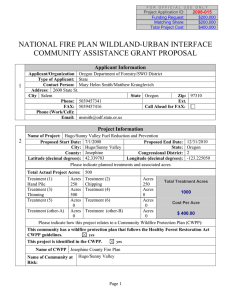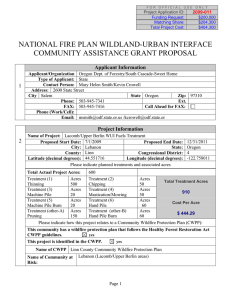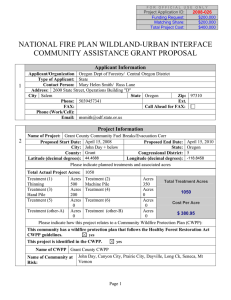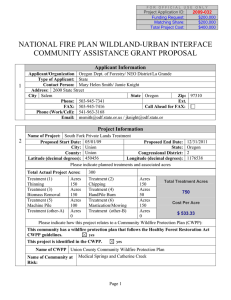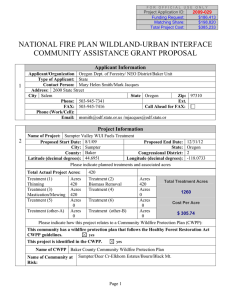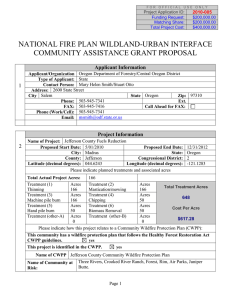NATIONAL FIRE PLAN WILDLAND-URBAN INTERFACE COMMUNITY ASSISTANCE GRANT PROPOSAL Applicant Information
advertisement
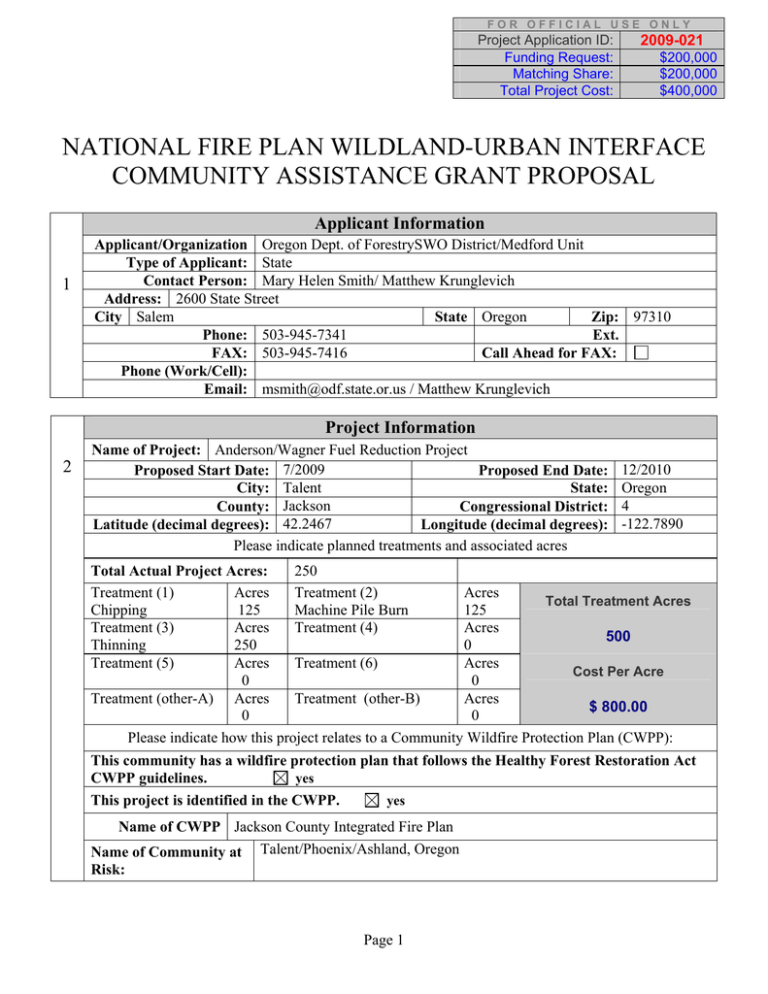
FOR OFFICIAL USE ONLY Project Application ID: Funding Request: Matching Share: Total Project Cost: 2009-021 $200,000 $200,000 $400,000 NATIONAL FIRE PLAN WILDLAND-URBAN INTERFACE COMMUNITY ASSISTANCE GRANT PROPOSAL Applicant Information 1 Applicant/Organization Oregon Dept. of ForestrySWO District/Medford Unit Type of Applicant: State Contact Person: Mary Helen Smith/ Matthew Krunglevich Address: 2600 State Street City Salem State Oregon Zip: 97310 Phone: 503-945-7341 Ext. FAX: 503-945-7416 Call Ahead for FAX: Phone (Work/Cell): Email: msmith@odf.state.or.us / Matthew Krunglevich Project Information 2 Name of Project: Anderson/Wagner Fuel Reduction Project Proposed Start Date: 7/2009 Proposed End Date: City: Talent State: County: Jackson Congressional District: Latitude (decimal degrees): 42.2467 Longitude (decimal degrees): Please indicate planned treatments and associated acres 12/2010 Oregon 4 -122.7890 250 Total Actual Project Acres: Treatment (1) Acres Treatment (2) Acres Total Treatment Acres Chipping 125 Machine Pile Burn 125 Treatment (3) Acres Treatment (4) Acres 500 Thinning 250 0 Treatment (5) Acres Treatment (6) Acres Cost Per Acre 0 0 Treatment (other-A) Acres Treatment (other-B) Acres $ 800.00 0 0 Please indicate how this project relates to a Community Wildfire Protection Plan (CWPP): This community has a wildfire protection plan that follows the Healthy Forest Restoration Act CWPP guidelines. yes This project is identified in the CWPP. yes Name of CWPP Jackson County Integrated Fire Plan Name of Community at Talent/Phoenix/Ashland, Oregon Risk: Page 1 Project Area Description All information for the project must fit into the space provided below. Attachments will not be considered by the review committee. 3 Provide a brief overview of the project and the project area. (If applying for a fuels reduction project, identify vegetation types, fire regime) [1500 Characters Maximum] Project propses to build upon the increasing awareness of wildfire danger by homeowners on Wagner Creek Road, Anderson Creek Road, and Coleman Creek Road. This area is checkerboarded with private industry, BLM, Forest Service, and over 315 private residents. Rapid fire spread from these areas is possible with steep southern aspect slopes and extreme fuel conditions. Adjacent Federal projects have been completed in the Ashland watershed. This is an area of serious concern for the Oregon Department of Forestry. Development is accelerating due to Measure 37 claims. The risk for catastrophic fire is extremely high due to topography, remote nature, inadequate access, and flashy fuels (manzanita, buckbrush, grass) with a high rate of spread leading to timbered stands along the ridge tops. Most of the landscape fall into the fire regime II where fires will be stand replacing. The fuel models around the structures is mainly brush and grass (Fuel model 7). Numerous landowners are direct neighbors to federal lands and private industry lands where fuel breaks will slow fire spread and drastically reduce structure loss in catastrohic wildfire. Adjacent BLM projects are Anderson/wagner. Project Timeline All information for the project must fit into the space provided below. Attachments will not be considered by the review committee. 4 Provide a timeline for the project. [500 Characters Maximum] -Summer/Fall 2009:Develop mailer to all landowners within the project area. Plan and implement community meetings. Begin home assessments & prevention education activities -Field visits begin in the summer, continuing into fall, winter and early spring . -Winter/Spring 2010: Grant awards, ongoing inspections -Continue initial home assessments, grant awards, final inspections and payments would be ongoing Page 2 Scope of Work All information for the project must fit into the space provided below. Attachments will not be considered by the review committee. 5 Provide a brief scope of work which clearly describes how grant funds will be spent. (This should be more specific than the project description) [1500 Characters Maximum] This grant will provide financial cost share incentives assistance to landowners to perform defensible space fuel reduction around 100 homes (1 acre each) and treat an additional 150 acres along driveways and in identifed stategic areas. Through a combination of ODF sponsored community meetings and one-on-one residential assessments, ODF will assist these rural residents to take action to survive catastrophic wildfire. These meetings will educate landowners about the actions they can take to reduce wildfire risk, technical resources they can refer to, and financial incentives to reduce fuels on their property. The Fire Wise program will be delivered along with information about the Jackson County Integrated Fire Plan. These presentations will educate landowners about the risk of wildfire in their community. ODF will provide fuels treatment to landowners with special needs (elderly, disabled, low income) at 100% cost. Interagency Collaboration All information for the project must fit into the space provided below. Attachments will not be considered by the review committee. 6 Specify the private, local, tribal, county, state, federal and/or non-governmental [501(c)(3)] organizations that will contribute to or participate in the completion of this project. Describe briefly the contributions each partner will make (i.e. – donating time/equipment, funding, etc.) [500 Characters Maximum] -Landowners - provide in-kind work as labor or cash to contractors for completing the fuels reduction work. -ODF: Staff & technical support, coordinating the development of outreach materials & prevention education materials -Rogue Valley Fire Prevention Cooperative: Interagency & intergovernmental coordination. -BLM Medford District- will coordinate with ODF on 3 fuels reduction projects being impemented or planned for the area. -Fire District # 5- Landowners contact for prevention educ Page 3 Project Longevity / Maintenance All information for the project must fit into the space provided below. Attachments will not be considered by the review committee. 7 Clearly describe how the proposed treatments will be maintained over time. [500 Characters Maximum] Cost-share agreements will be signed between ODF and the landowner. These agreements require the landowner to maintain the area for a minimum of 10 years from date of completion. Additional reminders are mailed periodically through the SB 360 program. These reminders include technical support and information. Ongoing monitoring is done by patrol and frequent visits to other fuel projects.. Biomass Utilization All information for the project must fit into the space provided below. Attachments will not be considered by the review committee. For the purpose of this application, biomass utilization is defined as any practicable end-use of the material that has value, or the trading of capital for the woody material. 8 Biomass from treatment(s) will be utilized. (check one) yes no 1) If yes, how is it planned to be used, or what is the end-result (wood products, steam/energy, mulch etc.) [500 Characters Maximum] Landowners will be consulted on the importance of utilization and marketing of products. Uses could include a fuel source for heat, or hauled to a near by facility that converts the produts into energy and mulch. Ongoing education and advancements will provide more oppurtunities to the county as Biomass utilization becomes more of an alternative for processing organic debris. 2) Identify company or contractors involved in project utilization. [250 Characters Maximum] Biomass One takes and processes organic debris from Jackson county and generates usable products such as energy and mulch. Contractors such as Lomakatsi have partnered with these companies to provide a flow of products. 3) Estimate anticipated value of biomass to be removed ($/Green Ton; $/Bone-dry Ton; $/Hundred Cubic Feet (CCF), $/Acre Treated) [250 Characters Maximum] Markets vary widely for biomass products in this region. Historically prices have ranged from $15$50 per bone dry ton. New legislation and tax programs will allow the market to increase these values. Page 4 Project Budget Cost Category Description Federal Agency Matching Share Applicant Landowner Total FD #5 Personnel $35,000.00 Forest Officer/Laborer 1 $8,000.00 Protection 4% Admin Subtotal $43,000.00 $79,340.00 $0.00 $79,340.00 $0.00 $0.00 $0.00 $5,000.00 $0.00 $5,000.00 $119,340.00 $8,000.00 $127,340.00 $18,200.00 $0.00 Subtotal $18,200.00 $0.00 $0.00 $0.00 $0.00 $0.00 $0.00 $0.00 $0.00 $0.00 $18,200.00 $0.00 $18,200.00 $11,640.00 Agency Field Vehicle $0.00 (.485/mi X 24000mi.) Subtotal $11,640.00 $0.00 $0.00 $0.00 $0.00 $0.00 $0.00 $0.00 $0.00 $0.00 $11,640.00 $0.00 $11,640.00 $0.00 $0.00 $0.00 $0.00 $0.00 $0.00 $0.00 $0.00 $0.00 $0.00 $0.00 $0.00 $0.00 $0.00 $0.00 $0.00 $0.00 $0.00 $0.00 $0.00 $0.00 $500.00 $1,000.00 $1,500.00 $115,660.00 $0.00 Subtotal $115,660.00 $0.00 $0.00 $0.00 $115,660.00 $0.00 $115,660.00 $0.00 $0.00 $0.00 $231,320.00 $0.00 $231,320.00 $10,000.00 $0.00 Subtotal $10,000.00 $0.00 $0.00 $0.00 $0.00 $0.00 $0.00 $0.00 $0.00 $0.00 $10,000.00 $0.00 $10,000.00 Fringe Benefits OPE Travel Equipment $0.00 $0.00 Subtotal $0.00 Supplies $500.00 Office/Field $1,000.00 GPS/Misc. Field Equip Subtotal $1,500.00 Contractual Fuel Treatments Other Business Serv 5% Indirect Total Costs $200,000.00 $79,340.00 $115,660.00 $5,000.00 $400,000.00 Project (Program) Income1 (using deductive alternative) 1 Program income is the gross revenue generated by a grant or cooperative agreement supported activity during the life of the grant. Program income can be made by recipients from fees charged for conference or workshop attendance, from rental fees earned from renting out real property or equipment acquired with grant or cooperative agreement funds, or from the sale of commodities or items developed under the grant or cooperative agreement. The use of Program Income during the project period may require prior approval by the granting agency. Page 5
